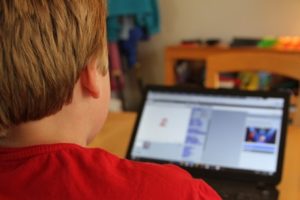By Dakota Antelman, Contributing Writer

Photo/Dakota Antelman
Hudson – Each week, close to two dozen students at Quinn Middle School in Hudson flock to the afterschool Scratch Club where school librarian Rolf Wasserman helps them learn the basics of computer programming.
Wasserman discovered Scratch and started the club in the fall of 2014. Developed by the Lifelong Kindergarten Group at the MIT Media Lab, Scratch is a programming language designed for children. It features blocks or commands that a user can snap together to create games, animations, music and more. For Wasserman, the simplicity of the program as well as the opportunity for innovation makes it ideal for his students.
“No one is dictating to them what they have to be learning about or what games or clips they have to be developing,” Wasserman said. “It’s really up to their own imagination as to what they want to do.”
At the Scratch Club, some students simply explore the public clips and games that other users have created while others eventually try programming themselves.
When the latter happens, Wasserman said he is often outpaced by his own students.
“This is a very intuitive program and this is a generation of kids that have grown up with touch screens and programming in one form or another,” he said. “A lot of them take to it like a duck to water. Just within a few weeks they know far more than I do. The best I can do is to facilitate their learning.”
When his students ask him a question he does not know the answer to, Wasserman said he does his best to study that specific part of the program and help the student. He added, however, that students often seek out help from one another, working as a group to solve problems with their individual projects.
This, he said, is part of the social aspect which draws many students to the club.
“It offers a lot of socialization for kids who might have trouble bonding with other kids during school hours. But if they have a common hobby afterwards, that can be a fun place for them to hang out,” Wasserman said.
The club has enjoyed popularity since its first year, with 60 students signing up for the 20 spots available in last years’ program with only minimal advertising. Wasserman said that this year, he was once again able to fill the 20 spots, this time with no advertising.
Jaxon Capobianco, a seventh-grade student, has been a club member since fifth grade and, each year, finds Wasserman in the library during the first week of school to sign up. So far, he has created two animations with the club, one which he was unable to finish, and another which he completed last year.
Capobianco, who will graduate from Quinn this spring, said he wants to create interactive games in his final year with the club. He echoed a sentiment that Wasserman said was key in his creating the club.
“It’s really fun and you can’t really be judged for what you make,” Capobianco said, adding that he hopes to keep participating in programs like the Scratch Club as he gets older.
Wasserman said he regularly talks with graduating seventh-grade students who, like Capobianco, say they want to participate in programs like Scratch Club in higher education. He hopes that either their schools can provide these opportunities, or that the students themselves will continue to learn about coding on their own.
“They talk about how they do want to pursue coding and how it naturally progresses to a more advanced programming language,” Wasserman said. “Scratch is great for beginners but it is also a great introduction to the whole field of coding.”











